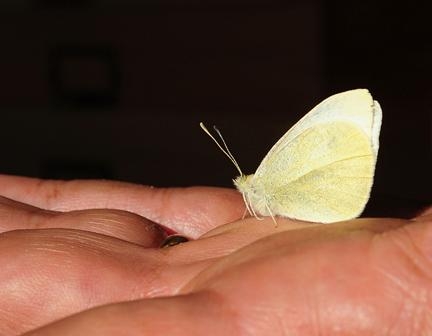Posts Tagged: cabbage
UC Davis entomologist spots first cabbage butterfly of the season
And it all has to do with butterflies and beer.
Shapiro collected the first cabbage white butterfly of the New Year on both of Obama’s inauguration days, Jan. 20, 2009, and Jan. 21, 2013.
“The constitution mandates the swearing-in for Jan. 20, though it does not require Pieris rapae to emerge on that date,” he quipped.
“Thank you, Mr. President!”
Shapiro, a professor of evolution and ecology who has monitored the butterflies of Central California for more than three decades, sponsors his annual “Beer for a Butterfly” contest to draw attention to the first flight of the cabbage white butterfly (Pieris rapae). Since 1972, he has awarded a pitcher of beer or its equivalent to the first person collecting the first cabbage white of the New Year within the three-county area of Yolo, Sacramento and Solano.
Shapiro, who is in the field 200 days a year, has won the contest every year except for the three times his graduate students, “my fiercest competitors,” took the prize.
Will Shapiro share his beer with the President? “I'd be delighted to buy Obama a beer, but I suspect he has better things to do with his time!”
Shapiro collected both of his Inauguration Day butterflies along railroad tracks in Yolo County. This year he found the prize-winner in West Sacramento. In 2009, he netted it in Davis.
Of his 2013 find, Shapiro said: “I knew at 9 a.m. on Monday, Jan. 21, that this would be the day - the air just felt different; the sun already felt warm, although the morning low at my place (Davis) had been 32 Fahrenheit at 6:50 a.m. That was the first time in 12 mornings that it hadn't gone below freezing.”
Shapiro arrived at his West Sacramento field site at 11:30 a.m., as the temperature hovered at 59 degrees. By 1:45, the temperature would top out at 66.
Shapiro prowled around the butterfly’s host plants, including wild radish and wild mustard. “Most of the annual Brassicaceae (mustard family), and milk thistle showed frost burn.”
At 1:01 p.m. a male rapae showed up. “It was flying from east to west along the north side of the railroad tracks, just east of the I-80 overpass,” said Shapiro, who was walking along the south tracks. “Unfortunately, at the exact same moment, a fast freight was approaching from the east and I was not about to race it across the tracks! As the train roared by, the butterfly rose straight up and flew over the overpass.”
“I've known all along that the day would come when I would see the first rapae but be unable to catch it,” Shapiro said. “The protocol for such an eventuality is: I count the sight record, but keep the contest open until someone actually catches one and turns it in. I figured this would be the year I'd have to do that. But after the train passed, I milled around looking to see if it would return.”
It did. “At 1:15 it appeared out of nowhere - I think it descended vertically from above - and went directly to where it had been when I first saw it.” He caught it immediately. “It's a male of proper (post-diapause) January phenotype. I waited around until 2 p.m. but saw no more rapae -- just one Red Admiral. So, two species, two individuals for the day.”
Shapiro’s first catch of 2013 was actually on Jan. 1 at the same site, but “it was a slopover from the fall brood.” He declared the contest still under way.
Shapiro, who shares his butterfly monitoring information on his Art's Butterfly World website, holds a doctorate in entomology from Cornell University, and is a fellow of the American Association for the Advancement of Science, the Royal Entomological Society and the California Academy of Sciences. He is also the recipient of UC Davis outstanding teacher and advisor awards.
As for his graduate students, the first to defeat him in his “Beer for a Butterfly” contest was Adam Porter in 1983. Sherri Graves and Rick Van Buskirk followed in the late 1990s.
This year’s competition, however, proved especially satisfying, given that 12 days of freezing temperatures preceded the catch and it occurred again on President Obama’s Inauguration Day.
“Pieris rapae is out, and I can ‘stand down,’ said Shapiro, declaring “It’s now officially spring.”
And as for sharing a beer with President Obama, that offer still stands, too.
Survey identifies 19 produce candidates for a farm-to-WIC program
A new federal voucher that gives low-income women access to a range of fruits and vegetables could provide unique new marketing opportunities for California growers.
In 2009, the federal Special Supplemental Nutrition Program for Women, Infants and Children (WIC) began distributing monthly cash vouchers to low-income women with children to buy fruits and vegetables. The program reaches almost half of the infants and one-quarter of children under 5 years old in the United States.
A team of UC Cooperative Extension (UCCE) researchers and nutrition advisors has been exploring the possibility of developing a farm-to-WIC program that would link these low-income consumers with local growers. The purpose of such a program would be to increase the consumption of a wide variety of fresh produce, with a focus on locally grown produce when available.
UCCE conducted a survey of produce preferences and buying habits among WIC participants in Tulare, Alameda and Riverside counties in 2010. The full study is published in the January-March 2012 issue of California Agriculture journal.
Based on the results, the UCCE team developed a list of 19 produce items to promote in a possible new farm-to-WIC program. They are:
|
|
|
Although mustard greens and collards were not popular across all sites, the advisors gauged a potential market in Alameda County, so these were retained. Based on write-in responses, oranges were also added.
In California, which has the nation's largest WIC program, 82 local agencies serve about 1.43 million participants at 623 local centers, and WIC participants can redeem their monthly vouchers at 4,000 grocery stores statewide. About 40 percent shop at WIC-only stores, which stock and sell only WIC-authorized foods.
Stocking produce is relatively new to WIC-only stores; before rollout of new WIC food packages in October 2009, these stores were only required to stock limited amounts of fresh carrots. In the survey, most WIC participants (58 percent to 72.3 percent) responded that their preferred stores offered many choices, but fewer participants (18.5 percent to 41 percent) rated the produce quality as “excellent.” Key factors determining purchase decisions were produce quality and freshness, and nutrient value (vitamins and minerals). Cost was relatively less important, possibly because WIC participants procure the produce with the vouchers.
The list has served as a starting point for discussions with growers and WIC vendors.
“The survey showed that WIC participants were interested in purchasing fresh produce with better quality and more variety,” wrote lead author Lucia L. Kaiser, Cooperative Extension specialist in the UC Davis Department of Nutrition, and co-authors, in California Agriculture. “Some WIC participants that we surveyed said they avoided shopping at WIC-only stores in part because these interests were not met.”

A dish made with nopales (cactus pads).


